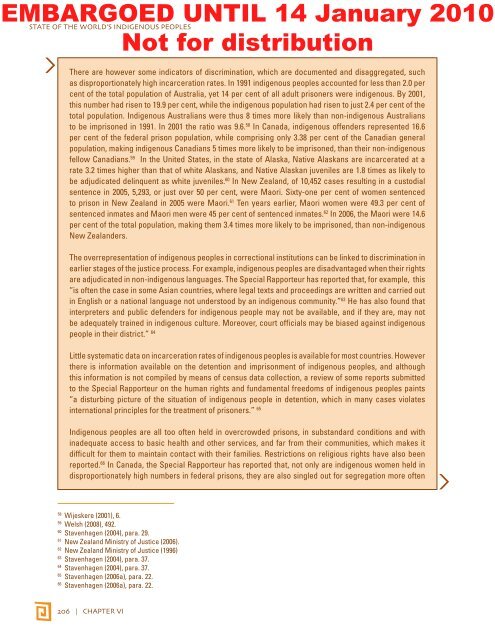STATE OF THE WORLD's INDIGENOUs PEOpLEs - CINU
STATE OF THE WORLD's INDIGENOUs PEOpLEs - CINU
STATE OF THE WORLD's INDIGENOUs PEOpLEs - CINU
- No tags were found...
You also want an ePaper? Increase the reach of your titles
YUMPU automatically turns print PDFs into web optimized ePapers that Google loves.
EMBARGOED UNTIL 14 January 2010<strong>STATE</strong> <strong>OF</strong> <strong>THE</strong> WORLD’S INDIGENOUS PEOPLESNot for distributionThere are however some indicators of discrimination, which are documented and disaggregated, suchas disproportionately high incarceration rates. In 1991 indigenous peoples accounted for less than 2.0 percent of the total population of Australia, yet 14 per cent of all adult prisoners were indigenous. By 2001,this number had risen to 19.9 per cent, while the indigenous population had risen to just 2.4 per cent of thetotal population. Indigenous Australians were thus 8 times more likely than non-indigenous Australiansto be imprisoned in 1991. In 2001 the ratio was 9.6. 58 In Canada, indigenous offenders represented 16.6per cent of the federal prison population, while comprising only 3.38 per cent of the Canadian generalpopulation, making indigenous Canadians 5 times more likely to be imprisoned, than their non-indigenousfellow Canadians. 59 In the United States, in the state of Alaska, Native Alaskans are incarcerated at arate 3.2 times higher than that of white Alaskans, and Native Alaskan juveniles are 1.8 times as likely tobe adjudicated delinquent as white juveniles. 60 In New Zealand, of 10,452 cases resulting in a custodialsentence in 2005, 5,293, or just over 50 per cent, were Maori. Sixty-one per cent of women sentencedto prison in New Zealand in 2005 were Maori. 61 Ten years earlier, Maori women were 49.3 per cent ofsentenced inmates and Maori men were 45 per cent of sentenced inmates. 62 In 2006, the Maori were 14.6per cent of the total population, making them 3.4 times more likely to be imprisoned, than non-indigenousNew Zealanders.The overrepresentation of indigenous peoples in correctional institutions can be linked to discrimination inearlier stages of the justice process. For example, indigenous peoples are disadvantaged when their rightsare adjudicated in non-indigenous languages. The Special Rapporteur has reported that, for example, this“is often the case in some Asian countries, where legal texts and proceedings are written and carried outin English or a national language not understood by an indigenous community.” 63 He has also found thatinterpreters and public defenders for indigenous people may not be available, and if they are, may notbe adequately trained in indigenous culture. Moreover, court officials may be biased against indigenouspeople in their district.” 64Little systematic data on incarceration rates of indigenous peoples is available for most countries. Howeverthere is information available on the detention and imprisonment of indigenous peoples, and althoughthis information is not compiled by means of census data collection, a review of some reports submittedto the Special Rapporteur on the human rights and fundamental freedoms of indigenous peoples paints“a disturbing picture of the situation of indigenous people in detention, which in many cases violatesinternational principles for the treatment of prisoners.” 65Indigenous peoples are all too often held in overcrowded prisons, in substandard conditions and withinadequate access to basic health and other services, and far from their communities, which makes itdifficult for them to maintain contact with their families. Restrictions on religious rights have also beenreported. 66 In Canada, the Special Rapporteur has reported that, not only are indigenous women held indisproportionately high numbers in federal prisons, they are also singled out for segregation more often58Wijeskere (2001), 6.59Welsh (2008), 492.60Stavenhagen (2004), para. 29.61New Zealand Ministry of Justice (2006).62New Zealand Ministry of Justice (1996)63Stavenhagen (2004), para. 37.64Stavenhagen (2004), para. 37.65Stavenhagen (2006a), para. 22.66Stavenhagen (2006a), para. 22.206 | CHAPTER VI
















